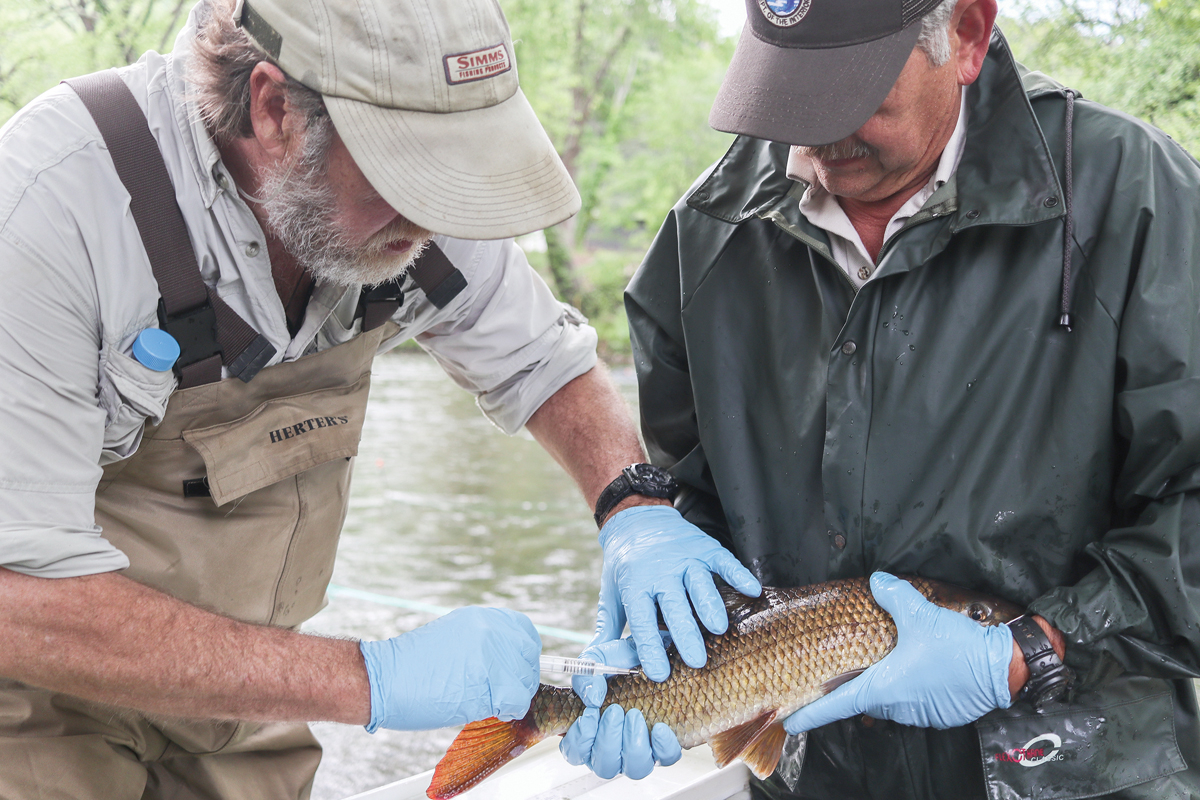Ecological opportunity: Ela Dam owner asks to let go of its hydropower license
 Biologists insert a tracking tag into a sicklefin redhorse. Gary Peeples/USFWS photo
Biologists insert a tracking tag into a sicklefin redhorse. Gary Peeples/USFWS photo
The owner of Ela Dam, a 99-year-old structure that sits about half a mile above the confluence of the Tuckasegee and Oconaluftee rivers, is asking the Federal Energy Regulatory Commission to let it surrender its license to generate power there.
The move could pave the way for ecological and cultural renewal along 1.5 miles of river.
“It would open up a lot of opportunity for restoration on the Oconaluftee, both on the physical level and the cultural landscape,” said Mainspring Conservation Trust Executive Director Jordan Smith. “From that standpoint, Mainspring is supportive of the application for sure.”
Request for surrender
Mainspring has been involved with discussions surrounding the dam’s future since shortly after operator Northbrook Power Management inadvertently released a massive amount of sediment in October 2021, blanketing the downstream reach and severely damaging its aquatic communities. The incident highlighted environmental issues associated with the aging dam, which was completed in 1925. A coalition formed to support removing the structure and thereby opening 549 river miles of the Oconaluftee River and its tributaries, connecting streams across the Qualla Boundary and parts of the Great Smoky Mountains National Park to the lower Oconaluftee and Tuckasegee Rivers.

Ela Dam was completed in 1925. Hunter Library/WCU photo
However, dam removal is not proposed in the application dam owner Northbrook Carolina Hydro II LLC has submitted to FERC. Instead, the company is merely asking the agency to let it surrender its hydropower license, given “the relatively small” amount of power the dam produces. Ela Dam has a generation capacity of only 980 kilowatts, just 20 kilowatts shy of 1 megawatt. Nearby Fontana Dam, by contrast, has a power generation capacity of about 300 megawatts.
Related Items
“The FERC license surrender is about just that,” said Erin McCombs, director of southeastern conservation for American Rivers. “It’s about Northbrook stopping their being able to generate hydropower on that [dam]. And then anything downstream of that is separate from what is happening here on this FERC license surrender. But it’s important step.”
In a 2022 FERC filing, Northbrook said the dam brings in only about $55,300 in annual net revenue and that “any meaningful attempt at active remediation” from the 2021 sediment dump would cost more than the dam’s aggregate net cash flow “over many years.” In a September 2022 letter, Northbrook said it had spent more than $400,000 in river restoration efforts. Violation cases stemming from the sediment dump handled by the N.C. Department of Environmental Quality and U.S. Army Corps of Engineers, which had required that Northbrook undertake those mitigation efforts, were closed in August and November 2022, respectively.
If the license surrender is granted, the application says, the property will likely be used for conservation.
“There is significant local support and interest in having the Project transferred to a local land trust or similar entity in connection with any such habitat restoration activities, which would only occur, if at all, subsequent to license termination,” the application states.
Northbrook has owned the dam since 2018 and operates under a 2011 FERC license granted to previous owner Duke Energy. That license isn’t set to expire until 2041. If FERC grants the surrender, the dam will be subject to regulation from the N.C. Department of Environmental Quality, and any activities involving entry into the Oconaluftee River in that area would require authorization under the federal Clean Water Act, typically administered by the U.S. Army Corps of Engineers. Northbrook also owns the Franklin Dam at Lake Emory and the Mission Dam on the Hiawassee River — those dams would not be affected by the requested license surrender at Ela.
Support from stakeholders
The application includes letters of support from several key agencies and organizations, including the Eastern Band of Cherokee Indians, Great Smoky Mountains National Park, Southern Environmental Law Center representing American Rivers, N.C. Wildlife Resources Commission, American Whitewater, U.S. Forest Service National Forests in North Carolina, Mainspring, U.S. Fish and Wildlife Service and N.C. Department of Environmental Quality. All of the above organizations offered their full support of the proposal.
“From the information available, we do not believe that license surrender would negatively impact the Oconaluftee River nor surrounding communities,” SELC Associate Attorney Alyson Merlin wrote on behalf of American Rivers. “To the contrary we believe that surrendering the license and transferring the dam to a local entity will beneficially empower the local community to determine the appropriate use of the dam. Accordingly, we support Northbrook’s application for simple and expedited license surrender.”
“Although the project is not on National Park Service land, Great Smoky Mountains National Park believes the decommissioning of the dam would be beneficial within the larger watershed,” wrote Smokies Superintendent Cassius Cash. “More specifically the effort would contribute positively toward reconnecting miles of native fish and mussel habitat, restoring natural river flows, and allowing access by highly migratory species like sicklefin redhorse and lake sturgeon to upstream spawning areas.”
The N.C. Department of Natural and Cultural Resources and U.S. Army Corps of Engineers weighed in as well, offering more neutral comments on the application. The Army Corps merely noted that based on the information currently available, it was unable to say whether a Department of the Army permit would be needed in connection with the decommissioning.
The Department of Natural and Cultural Resources said that in 2003 the dam and powerhouse were deemed eligible for listing in the National Register of Historic Places and that the license surrender would “result in a foreseeable adverse effect” to the structures. However, “understanding the reasons for the proposed license surrender and the ultimate demolition of the historic property,” the department said, it was prepared to enter a consultation process that would “mitigate the loss of the historic property through the use of photographic and mapping documentation as well as development and implementation of some form of public education tool about the historic properly.”

Ela Dam is 341 long and 36 feet high. File photo
However, the application does not call for demolition of any buildings or structures. While dam removal has been discussed in the past and may be discussed in the future, the proposal currently before FERC concerns only the license surrender. Dam removal would require a separate process at a later date. The plan outlined in the application calls only for disconnecting the generator from its connection point with Duke Energy’s grid and removing generators and turbines.
The canoe portage and river access will continue to be maintained so long as Northbrook owns the property. Any future owner would have the ability to modify recreational facilities and public access points in connection with other conservation and restoration activities.
More than a dam
Regardless of what’s in store for the dam itself, the opportunities for ecological and cultural restoration projects on the property are huge, Smith said. Northbrook owns a total of 131.6 acres along the Oconaluftee River in Swain County, with all parcels save the dam site taking the form of long, skinny tracts that border 1.5 miles of the river upstream of the dam.
“The potential is way more than just the dam,” Smith said. “You’re talking about a mile and a half plus, of critical habitat for listed species. So, definitely, yes, there is potential there. And that’s on top of and intertwines with the cultural component. Those things are inseparable — the biological and cultural components associated with this project.”
That stretch of river abuts the Eastern Band of Cherokee Indians’ Qualla Boundary and is home to the federally endangered Appalachian elktoe mussel and to the eastern hellbender, a rare giant salamander that is listed as a species of special concern in North Carolina.
It’s also vital habitat for the sicklefin redhorse, a fish that is on the state’s endangered species list and has special cultural significance for the EBCI. In Cherokee, the fish is called Ugiidatli, a name that references the appearance of the fish’s dorsal fin, roughly translating to “wearing a feather.” It can reach 2 feet in length, so its large size coupled with its predictable spawning runs made it an important food source for the Cherokee people.
Despite its long cultural history among the Cherokee, the sicklefin redhorse didn’t gain official recognition as a unique species until 1992. The fish has a small range, being found primarily in the Hiwassee and Little Tennessee rivers, with migration into smaller streams within those watersheds such as the Oconaluftee, Tuckasegee, Valley River and Brasstown Creek. Wildlife experts estimate that half of the known population in the Tuckasegee River basin spawns in the Oconaluftee River.
“When you have three species like that, that are in one place, we want to look at all the opportunities for restoration — upstream, downstream of the dam, all of the above,” Smith said.
But that opportunity is far from guaranteed. Northbrook submitted its license surrender application in November, but FERC has yet to officially accept it.
“Once we determine the surrender application is complete, we will issue a public notice seeking comment on the application,” said Celeste Miller, media relations representative for FERC.
That notice would kick off FERC’s formal approval process. If approval is granted, Northbrook would then be able to take its generators offline and consider transferring ownership of the property to a conservation organization like Mainspring.
McCombs said she’s hopeful good things will come from the effort.
“I think we’re seeing this turning point where folks are really celebrating the values of rivers, and that’s really important, because we depend on them,” she said. “There’s a lot of benefits that come with looking at restoration — climate change benefits, both adaptation and mitigation, and justice issues, and of course, the incredible biodiversity that we have here in the Southeast.”









